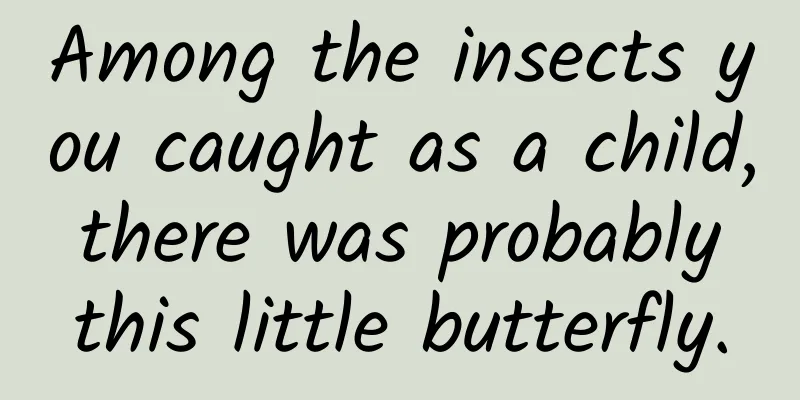Among the insects you caught as a child, there was probably this little butterfly.

|
When I was young, I loved all kinds of insects. Of course, I didn't know these insects at that time, let alone understand them, and I had no way to find relevant books to study and explore; it's better to say that I like to catch them than to like them. This hobby probably came from my grandmother - she always took me to the green belt of the Second Ring Road at that time to catch insects: from grasshoppers and mantises to butterflies and dragonflies; we have been doing this since I can remember. Cloudy White Butterfly | Wu Chao Thirty years ago, Beijing was not as developed as it is now. There were a lot of wastelands and even farmlands just outside the second ring road. These environments naturally gave birth to a large number of insects of all shapes and sizes. Today, I often recall the insects I caught at that time, and use the little knowledge I have now to judge their names; and the cloud butterfly, with its unique and easy-to-identify appearance, is the first insect that I can remember that can be named. Front view of the Clouded White Butterfly | Mick Sway / Flickr Common Butterflies in Cities The white butterfly is not uncommon in densely populated northern and eastern cities. You may not have noticed them, but you must have passed by them. This is a small and medium-sized white butterfly that looks mottled white. Its appearance is quite standard among butterflies, and it looks like a standard "little white butterfly". The front of these lively little butterflies' wings are white, with obvious dark brown cloud-like spots on the edges of the front and back wings, and a large spot on the outer edge of the middle chamber of the forewing; the back of the wings is also white, but there are obvious yellow-green cloud spots on the edges of the forewings and the entire hindwings; because the middle and rear parts of the forewings are often covered by the hindwings when the butterflies land, the white butterfly in its resting state looks like a white and green, light and dark mottled color - this also allows them to hide better in the grass and be difficult to be discovered by natural enemies. A pair of blue butterflies mating on Lythrum salicinae | Wu Chao The genus Pieris, to which the Pieris belongs, has few species but is widely distributed. They are typical northern species; and the Pieris species is also widely distributed throughout the Palearctic, stretching from Europe to eastern Asia. In my country, the genus Pieris contains three species, of which Pieris is the most common. They are common in many northern provinces, and are also distributed southward to Jiangsu, Sichuan, and even southern provinces such as Yunnan and Guangxi. In cities, like the more common Pieris rapae, the larvae of Pieris rapae also feed on cruciferous plants, and their hosts include a variety of cruciferous weeds commonly found in urban green spaces, making them one of the most common butterflies in urban environments. The life of the Cloud Butterfly Like all Lepidoptera, the cloud butterfly is also a holometabolous insect. Its life cycle includes four stages: egg, larva, pupa, and adult. Female cloud butterflies lay long columnar eggs directly on the leaves of the host plant to ensure that the newborn larvae can eat food as soon as possible. The small larvae grow very fast. The older larvae of the cloud butterfly have an ordinary appearance, which is a very standard caterpillar appearance. There are blue-gray vertical stripes running through the head and tail on the yellowish body, and small black spots are scattered all over the body. The task of the larvae is to work hard and pupate as soon as possible, but their fate is not as easy as it seems. Many larvae will be invaded by parasitic wasps at this stage, and eventually die in the larval or pupal stage. Pieridae, probably the pupa of Pieris rapae. You can see a very thin thread on the chest that is used to fix the pupa's body. | Wu Chao In the cruel nature, only larvae with good luck can successfully grow into butterflies. Mature larvae of the Pieris genus will pupate on plants or walls. Similar to the pupae of the swallowtail butterfly, the larvae of the Pieridae family will also use a circle of silk thread to fix their bodies. The difference is that the pupae of the Pieris genus often cling to the attachment, instead of having a significant angle like the pupae of the swallowtail butterfly. In summer, the pupae of the Pieris genus can fully develop in about a week. The adult will drill out from the crack on the back of the pupa and gradually spread its wings through hydraulic pressure; the emergence time of butterflies is not long, usually less than an hour, and they can make their first flight. Apollochaetes visiting a flower | Alastair Rae / Wikimedia Commons Adult cloud butterflies no longer chew on plant leaves like larvae. Their mouthparts are specialized into a curled straw-like structure to suck up liquid food such as nectar. This type of mouthpart is called a "siphon mouthpart" in entomology. These completely different habits are often considered to be able to effectively avoid competition for resources between adults and larvae, which may be one of the reasons for the prosperity of holometabolous insects. The reason why the white butterfly is so common is that it can adapt well to urban life and thrive in a small green space. Another important factor is that the white butterfly can continue to reproduce and develop in the season with suitable temperature, unlike many butterflies that have a long dormant period. The white butterfly has multiple generations a year and overwinters as pupae in the north. In Beijing, the first generation of white butterflies can be seen in late March every year. They are individuals who pupated in the autumn of the previous year. A blue butterfly visiting a flower | Ettore Balocchi / Wikimedia Commons After a long winter, this generation of butterflies is significantly smaller in size. They will emerge and begin to reproduce as soon as the cruciferous plants begin to grow in the spring. After that, their offspring will reproduce for many generations throughout the year, and their mottled figures can be seen flying among the flowers and plants until late October. Now that August is about to pass, why not choose a weekend and go look for the butterflies around us in this cool and refreshing autumn season. |
Recommend
360 Business Product Launch Guide and Product Strategy
Preface: As the second largest search engine manu...
When the weather gets cold, I always want to eat...How can I eat to better cope with the cold winter?
In cold weather, in addition to wearing more clot...
Cao Yu Back Training Baidu Cloud Download
Cao Yu back training resource introduction: Cours...
Red Planet · Introduction to short videos in physical stores, how to shoot and edit ideas, Dou Pod is worth 999 yuan
Red Planet·Introduction to short videos in physic...
As the entrance to 1 billion traffic, will mini-program games be the key?
Summarizing 2018, which is already halfway throug...
Color TV giants focus on quantum dot technology, which is a breakthrough
At this stage, OLED TVs have not yet entered the ...
Do you understand App promotion thinking?
A friend asked me yesterday: How long do you thin...
Why doesn't Apple use an "iWatch"?
According to Reuters, Apple Inc. (hereinafter ref...
Are sugar substitutes the perfect "substitute" for sugar? Friends who love sweets, take a look!
Colorful donuts Rich and smooth chocolate Sweet a...
Is it true that looking into each other's eyes for 60 seconds can make people fall in love with each other?
There are often such clips in movies and TV drama...
Twist your own head off for fun. Can a headless fly survive?
Flies crawl over all kinds of dirty things and on...
On the International Day for Biological Diversity, please check out these "magical animals" emojis
Big red lips, blue feet, yellow eyebrows... There...
Today is the Winter Solstice | Should we eat dumplings or glutinous rice balls?
In your hometown Should we eat dumplings or gluti...
Android 12 new version details: follow iOS 14 to improve user privacy experience
Some developers have found that in the new versio...
5 major trends in brand marketing in 2021
Among the top ten popular slogans, Yuanfudao (A t...









